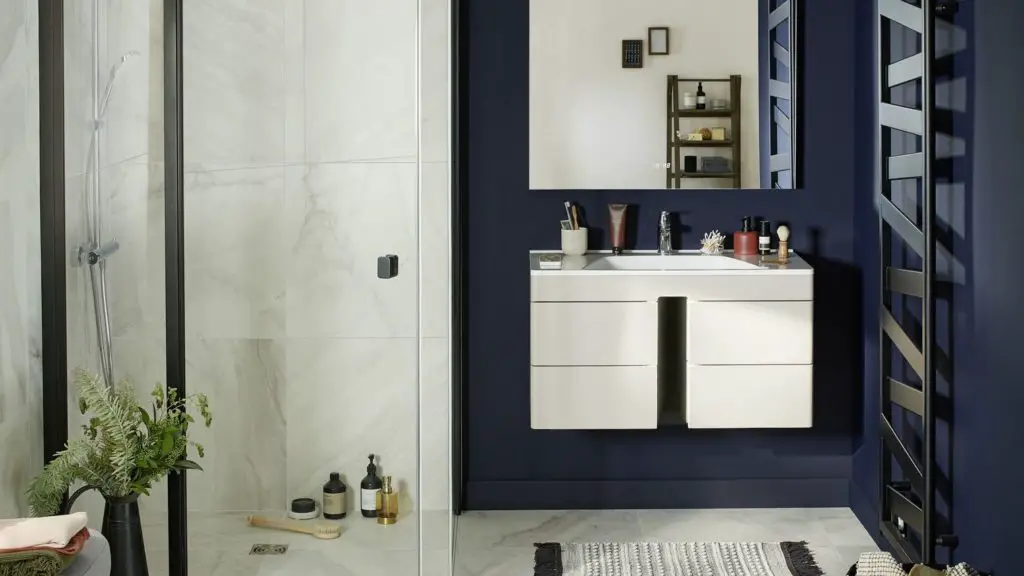What kind of paint should you use in a bathroom? Painting bathroom walls is the most popular, fastest, and easiest way to renovate your interior. We will tell you how to choose the right paint and what factors you need to know.
The main thing in the finishing is to use quality materials, and the wall surface will remain beautiful and spectacular for a long time. For bathroom wall painting, you can invite a specialist. On the other hand, why not try yourself as a painter, to paint the walls in the bathroom?
Modern materials make it easy to experiment, but remember bathroom paints should be waterproof, with bacterial protection. Water dispersion paints are the most suitable, especially based on materials such as latex or acrylic. It is an emulsion that consists of water and micro polymers.
When you apply them on walls, water evaporates when dry and the bonding base (polymers) remains sticking to each other. This creates a moisture-resistant protection. The water-dispersion paint is considered the most convenient to apply on the surface and belongs to the more economical variants.
What Kind of Paint Should You Use In a Bathroom?
1. Waterproof Paints
Each manufacturer has a range of waterproof paints, specialized, for wet rooms. Water dispersion paints, resistant to constant water impact, are the most popular. They last for a long time, dry quickly, and do not have a strong odor.
A very important feature of bathroom paints is their ability to repel steam. Moreover, pay attention to the composition, so that it necessarily contains fungicides and algicides. They prevent mold or fungus from spreading.
An important point: so that no cracks form on the walls you paint afterwards, and the surface has a spectacular and attractive appearance, apply the coloring agents to completely dry walls. Otherwise, condensation will form under the coating, which will lead to a deterioration of the decorative properties of the paint.
If you apply decorative plaster, it is better to focus on those species that use wax or water dispersion varnish. They will provide protection from water droplets and humid environment.
2. Water-Dispersion Paint
The main advantage of water-dispersion paint is that it is not toxic, and you can dilute it with water easily and quickly. It is also attractive because it dries very quickly, on average in 1.5-2 hours. And at a temperature of 18-22 degrees, you reduce the drying time to half an hour. So you can easily handle the role of a painter.
This paint is more durable, it is not afraid of temperature changes and passes vapors, which allows walls to breathe. Furthermore, these surfaces are easy to wash, and not afraid of detergents.
It’s our opinion:
3. Oil Paint
For comparison, let’s take the oil paint as an example. In the past, it was the most popular for painting bathroom walls. But it dries for quite a long time (more than a day), and has an unpleasant specific smell. After a while it can crack, and the process of removing it from the surface is very laborious.
Paint If Kept In the Cold
You shouldn’t buy paint if it’s kept in the cold. Remember, water is its component. And if it freezes over, the paint’s structure will break. Accordingly, you will not get a quality result.
Further, you should carefully prepare the surface of the walls for painting. For this purpose, first remove all previous facing coatings. Use tools such as scrapers, spatulas, as well as a sandpaper.
Further, use a latex primer with antibacterial properties. Then, treat surfaces with it 2-3 times. After you apply each coat, the primer should completely dry.
What Kind of Paint Should You Use In a Bathroom – Paint Several Coats
To get a quality result, you should paint the prepared bathroom walls with several coats. If you approach the process creatively, it will be fascinating and interesting.
First, it is necessary to paint all corners and hard-to-reach places with a brush. Only then, treat the whole surface with a roller. But to get a thicker layer and smooth out all the irregularities, it is better to apply the first layer of brush too.
For the first coat, dilute the paint by 10-15%. Wait until the surface is completely dry, and only then apply a second coat of paint.
Our opinion:
– To obtain a uniform color, it is best to mix all the paint in containers. The point is that the paint can be different in shade, even if it is in the same cans. And so you get a medium uniform shade.
What Kind of Paint Should You Use In a Bathroom – Use a Sprayer, Roller and Brush
For wall painting, you can use a sprayer, roller and brush. The water dispersion paint is suitable for all tools.
You will get smoother and better results with the sprayer. The main thing is to wash it well after applying the next coat.
Thanks to the brush, the paint is laid down tightly, but its consumption increases.
You can save money if you treat walls with a roller. It allows you to apply the paint in an economical thin layer, but fine irregularities and corners are harder to work with it.
It’s worth remembering that the larger the area to paint, the wider the choice of roller.
– We all know that the bathroom is a room with high humidity, so you need to follow a few rules to make further use of it a pleasure. One of them is that the room should have excellent ventilation and preferably spacious.
You can paint surfaces that do not come into contact with water. Accordingly, it is desirable to protect the places around the bathtub, shower cabin, washbasin from water. For example, you can use tile or glass for protection.


